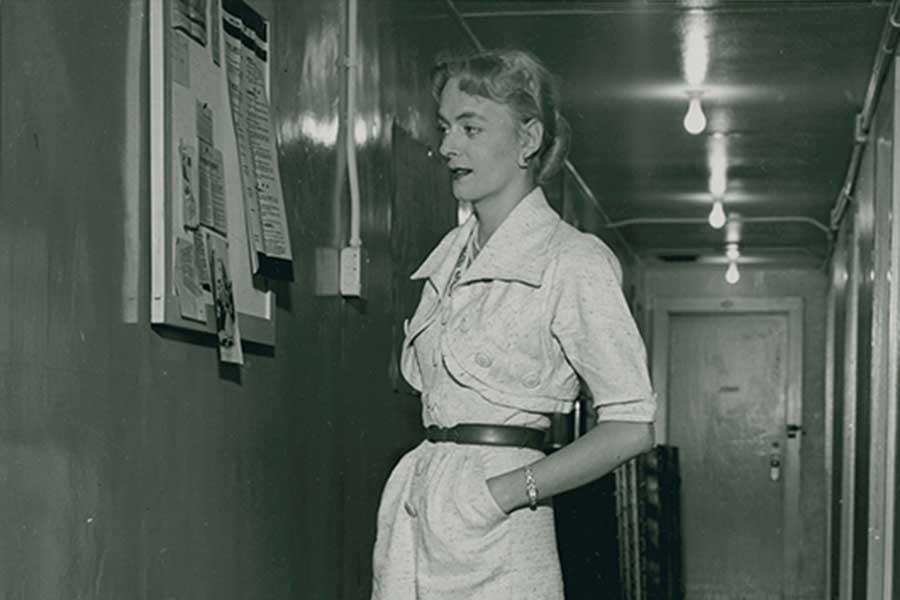“Bring Your Own Body,” a new exhibit on display in the Cantor Fitzgerald Gallery at Haverford College, celebrates transgender history and creativity. The show, which runs until Dec. 11, is free and open to the public.
The exhibit debuted last fall at Cooper Union in Manhattan. It mixes archival material with work made by 17 contemporary transgender or gender-nonconforming artists, including Justin Vivian Bond and Chris E. Vargas.
The pieces on display in “Bring Your Own Body” come in a variety of media, from fabric art to sculpture. There are also ’zines, police photos — even doodles by an eminent sexologist.
The show is broad enough to encompass many perspectives. Viewers can see both the dark, disturbing photographs by the French surrealist Pierre Molinier and “Southern for Pussy,” an amusing video by Zackary Drucker, a producer on the television show “Transparent.”
According to Jeanne Vaccaro, who curated the show with Stamatina Gregory, “Bring Your Own Body” offers a rare opportunity to view archival material that is usually restricted to scholars.
“This is a really special, temporary, finite kind of thing,” Vaccaro said. “So we would love for people to have a chance to come and see this work, which has really not been ever made available to the public.”
Vaccaro, whose field is gender studies, first conceived the idea for BYOB while on a research fellowship at Indiana University’s Kinsey Institute. Although she had studied transgender art and activism for years, she was struck by the abundance of trans-related material housed there.
Vaccaro thought the public would be interested in seeing it too, so for roughly a year she pored over documents, photos and ephemera that Kinsey and his associates filed under “TV” for “transvestite.” Although the term is outdated, it was clear to her that there was some continuity with what is now called “transgender.”
The archival material is thought-provoking. There is a huge difference, for example, between the candid black-and-white snapshot of Louise, a self-identified transsexual who corresponded with Dr. Kinsey, and the police photos of African-American drag queens taken after their arrest.
Even though some of these images are problematic, Vaccaro still felt strongly that they should be made public.
“Part of what the exhibit is trying to play with is to confront the ethical ambiguity of how these individuals were categorized and classified by these doctors and scientists,” she said.
What these medical reports and sensational newspaper articles needed, Vaccaro continued, was “a critical intervention from contemporary artists to talk about how to negotiate those inherited representations of trans identity, which can be kind of pathologizing.”
Juxtaposing the work of contemporary transgender artists with archival material makes it clear that being transgender is hardly a new phenomenon.
“Part of what the show wants to do is point to that longer history and to show how trans folks have been forging their own survival through creativity, resistance and resilience for many decades,” Vaccaro said.
To emphasize that continuity, the curators looked for artists whose work incorporated what Vaccaro referred to as an archival component and intergenerational practices. Buzz Slutzky, who has two pieces on display in BYOB, exemplifies both. From 2010-12, Slutzky, who prefers the gender-neutral terms “they/them,” was curator of the Pop-Up Museum of Queer History. They are proud to have their work included in BYOB.
“Chloe Dzubilo and Greer Lankton are artists that I consider ancestors — transcestors, if you will,” Slutzky wrote via email. “Knowing their work and being in community with the people they considered family helps me understand my own history, which is so valuable. I can make my work in a tradition, which not every young artist gets to have.”
Slutzky’s work is also an opportunity for them to explore the experience of being non-binary. “Double Incision,” a wall sculpture, is part metalwork, part crafts project. As a student at Parsons, they learned to weld and noticed that the welded line resembled the double-mastectomy scar from top surgery. It also looks a bit like a smiley face.
“Craft materials are still associated with ‘women,’ and welding is still considered a ‘man’s tool,’ so I wanted to juxtapose them in a corporeal way to challenge the separation of those bodies,” Slutzky said.
That willingness to play with ideas and materials extends to the exhibit itself. A unique feature of BYOB is the collection of periodicals that visitors are welcome to browse. Among them are many issues of Transvestia, a magazine published by Virginia Prince from 1960-80.
These publications were generously donated by the Transgender Archives at the University of Victoria with the express purpose that they be available to attendees. So far, that hasn’t been a problem.
“You think of an art opening as people drinking wine and networking and being very sociable,” Vaccaro said, recalling the show’s New York debut. “And people were just being total nerds and reading over those in the middle of an art opening.”
Fortunately, locals curious about transgender culture don’t need to travel to Manhattan to see BYOB; it’s right here in our backyard.
To learn more about BYOB, visit www.exhibits.haverford.edu/bringyourownbody.

